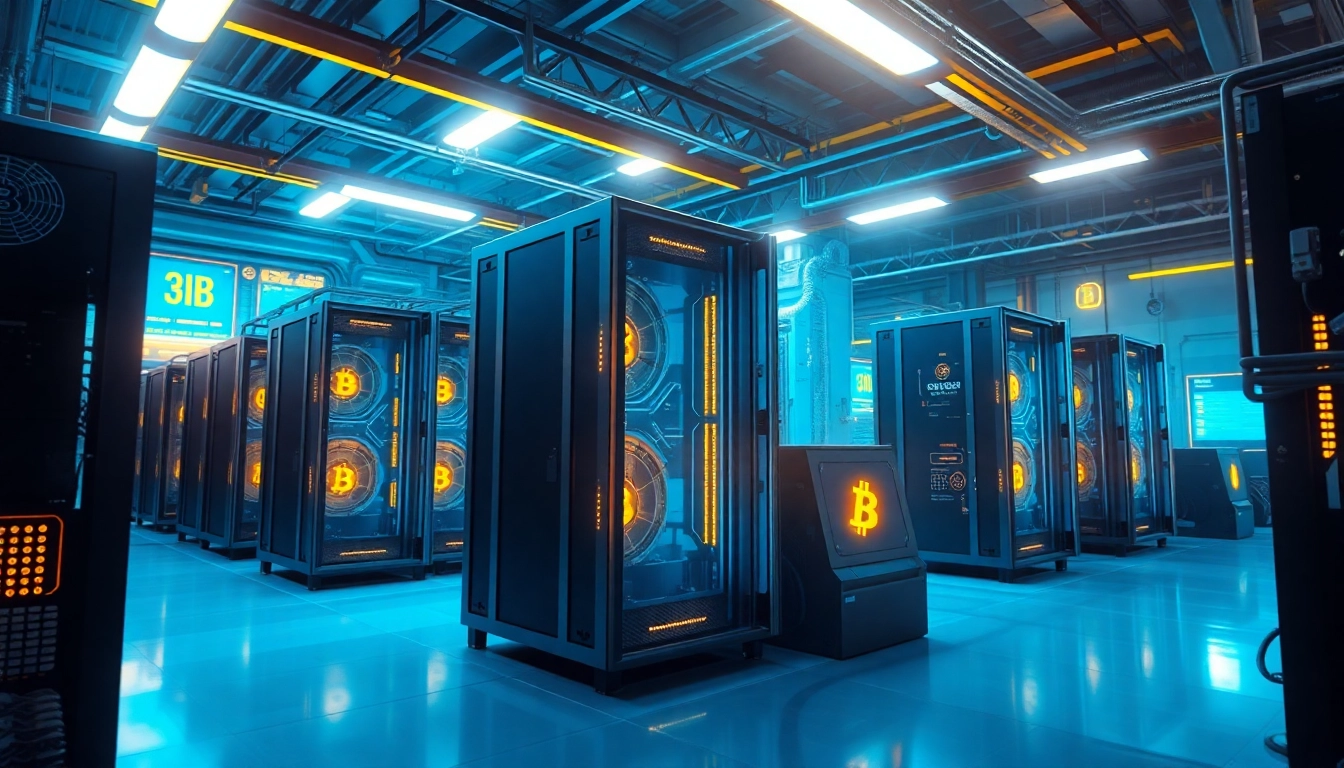Understanding Bitcoin Mining Basics
Bitcoin mining serves as the backbone of the Bitcoin network. It is the process that enables transactions to be verified and added to the public ledger known as the blockchain. In essence, Bitcoin mining involves using computer hardware to solve complex mathematical puzzles, which is crucial for maintaining the network’s integrity and security. This guide delves into the fundamentals of Bitcoin mining to help you grasp its essential components and functionalities.
What is Bitcoin Mining?
Bitcoin mining is the process of validating transactions on the Bitcoin network. It involves miners competing using computing power to solve cryptographic puzzles. Successfully solving these puzzles allows miners to create new blocks of transactions. Each time a block is mined, the miner is rewarded with newly minted bitcoins and transaction fees paid by users sending bitcoins. This process is integral to the Bitcoin ecosystem as it ensures the decentralization and security of the currency.
The Role of Miners in the Bitcoin Network
Miners play a critical role in the Bitcoin network by acting as validators of transactions. When a user initiates a Bitcoin transaction, it is broadcast to the network, where miners collect it along with other transactions into a block. Using the Proof of Work method, they compete to solve a specific mathematical problem. The first miner to solve the problem broadcasts their solution (the new block) to the network, where it undergoes verification by other miners. This process prevents double-spending and confirms the transaction’s legitimacy, thereby preserving the network’s integrity.
Why is Bitcoin Mining Important?
Bitcoin mining is fundamental to the overall functioning of the Bitcoin network for several reasons:
- Transaction Validation: It ensures that all transactions are legit and prevents fraudulent activities.
- Security: By requiring a substantial amount of computational power to alter the blockchain, it deters malicious attempts to manipulate the network.
- Decentralization: With many miners around the world, it prevents any single entity from controlling the Bitcoin network.
- New Bitcoin Creation: Mining is the method by which new bitcoins enter circulation, ensuring a steady supply until the maximum limit of 21 million bitcoins is reached.
How Bitcoin Mining Works
The Mining Process Explained
The mining process can be broken down into several fundamental steps:
- Transaction Broadcast: Users send transactions to the Bitcoin network.
- Transaction Validation: Miners collect these transactions, verify their validity, and add them to a candidate block.
- Solving the Puzzle: Miners compete to find a nonce (a random number) that, when hashed, produces a hash with a specific number of leading zeros.
- Block Addition: The first miner to identify the correct nonce broadcasts their block to the network.
- Block Verification: Other miners confirm the block’s validity and add it to their own copies of the blockchain.
Types of Bitcoin Mining
There are several methods for Bitcoin mining, each with distinct characteristics:
- Solo Mining: Individual miners operate independently, working solely to mine bitcoins. This method is less common due to the growing difficulty of mining.
- Pooled Mining: Miners combine their computational resources to increase the chances of solving a block. Rewards are distributed proportionally based on the hashing power contributed by each miner.
- Cloud Mining: Users lease mining power from data centers and don’t have to deal with the complexity of maintaining their own hardware.
Mining Algorithms and Proof of Work
Bitcoin utilizes the Proof of Work (PoW) algorithm, which requires miners to solve complex mathematical challenges. This makes it computationally expensive to achieve a successful block creation, effectively ensuring that the network remains secure and resistant to attacks. PoW necessitates a significant investment in specialized hardware, which creates a barrier to entry for those wanting to mine Bitcoin.
Choosing the Right Bitcoin Mining Hardware
Essential Mining Equipment
The hardware used in Bitcoin mining greatly impacts profitability and efficiency:
- ASIC Miners: Application-Specific Integrated Circuits (ASICs) are the most popular and efficient hardware currently available for Bitcoin mining. These machines are designed specifically for the mining process, allowing for higher hash rates.
- GPUs: While they were once the standard for mining, Graphics Processing Units (GPUs) are less effective for Bitcoin mining compared to ASICs.
- Mining Rigs: These setups combine multiple GPUs or ASICs into a single system to optimize processing power, although they require an understanding of both hardware and software.
Cloud vs Hardware Mining: Pros and Cons
When considering mining options, individuals must weigh the benefits and drawbacks of cloud mining versus owning physical hardware:
Cloud Mining Pros:
- No need to maintain hardware or technical knowledge.
- Scalability options are more flexible.
- Access to mining power without geographical restrictions.
Cloud Mining Cons:
- Less control over mining operations.
- Potential for scams and unreliable services.
- Fees that can eat into profits.
Hardware Mining Pros:
- Full control over mining operations.
- Ability to repurpose hardware for other tasks.
- Potential for higher long-term profitability if well-managed.
Hardware Mining Cons:
- High upfront costs for purchasing and maintaining equipment.
- Technical knowledge required to set up and manage mining operations.
- Risk of hardware obsolescence as technology advances.
Factoring Electricity Costs
Electricity costs significantly impact the profitability of Bitcoin mining. Miners must consider the following aspects:
- Energy Efficiency: Choosing energy-efficient mining hardware can drastically lower electricity bills.
- Geographical Considerations: Electricity rates vary significantly by region; miners often seek locations with cheaper energy to increase profits.
- Public Policies: Understanding local regulations and energy policies can yield benefits in terms of costs and sustainability.
Optimizing Your Bitcoin Mining Operation
Best Practices for Efficient Mining
For miners seeking to maximize efficiency and profits, consider the following best practices:
- Regularly upgrade hardware to ensure mining efficiency and speed.
- Implement cooling systems to prevent overheating and ensure hardware longevity.
- Utilize mining software that optimizes GPU and ASIC performance.
Monitoring and Scaling Your Mining Setup
To ensure successful operations, miners should consistently monitor their setups for optimal performance. This includes tracking:
- Hash rates and network difficulty levels.
- Electricity consumption and costs.
- Profit margins based on current Bitcoin prices to determine when scaling up, or scaling down, operations is necessary.
Common Pitfalls in Bitcoin Mining
Miners face several challenges that can hinder their success:
- Neglecting Fees: Transaction and pool fees can add up, so it’s vital to account for them in profit calculations.
- Overestimating Returns: The volatile nature of Bitcoin can lead to unrealistic profit projections; be cautious with financial planning.
- Ignoring Key Updates: Stay informed on changes to mining software or hardware developments to remain competitive.
Legal and Environmental Considerations
Regulations Surrounding Bitcoin Mining
Bitcoin mining is subject to various regulations that can impact operations. These may include:
- Licensing Requirements: Some regions require miners to apply for specific licenses to operate.
- Tax Regulations: Miners must report earnings and may be subject to taxes depending on local laws.
- Environmental Compliance: Compliance with local environmental laws can affect mining operations, particularly in areas facing scrutiny over energy consumption.
Impact of Bitcoin Mining on the Environment
The environmental impact of Bitcoin mining is a topic of significant debate. Critics argue that the high energy consumption associated with mining operations contributes to increased carbon emissions and contributes to the depletion of natural resources. Advocates point out that many miners are seeking renewable energy sources or are located in regions where surplus energy is available, lessening the negative impact.
Steps to Minimize Your Carbon Footprint
To reduce the environmental impact of Bitcoin mining, consider taking the following steps:
- Utilizing Renewable Energy: Invest in renewable energy sources such as solar or wind power for your mining operations.
- Energy Efficiency Measures: Implement hardware upgrades and cooling techniques to reduce overall energy consumption.
- Offset Carbon Emissions: Consider purchasing carbon credits or investing in reforestation projects to offset carbon footprints.


